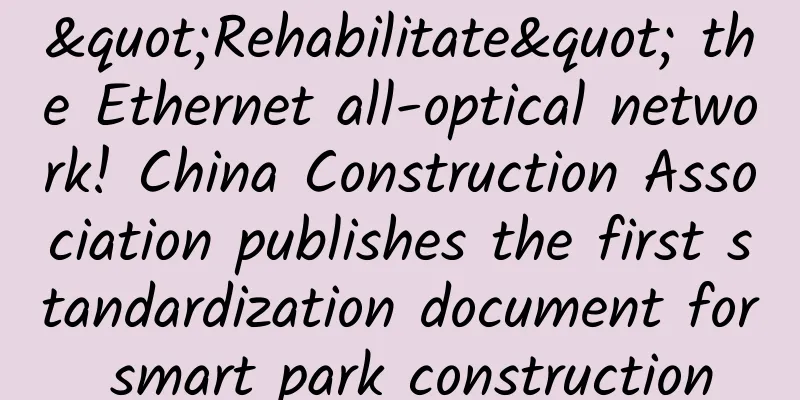"Rehabilitate" the Ethernet all-optical network! China Construction Association publishes the first standardization document for smart park construction

|
"Smart Park" is not a new concept. In today's urban planning and social development, smart parks are becoming the focus of attention of all parties, but there are many different opinions on how to build high-quality smart parks. Facing such a market with a scale of hundreds of billions, the faster the development and the more diverse the demands, the more important it is to formulate standards in the process of promoting digital and intelligent construction. On May 1 this year, the standardization document on the construction of smart parks, "Technical Regulations for the Construction of Ethernet All-Optical Networks in Smart Parks" (hereinafter referred to as "Regulations"), was officially implemented. This is the first standardized document on smart park construction released by the China Construction Industry Association. The standard mainly introduces the key technologies and implementation of Ethernet all-optical network construction in smart parks, filling the technical gap in the standardization of all-optical network construction in smart parks using Ethernet technology. In a sense, this document can be said to be a "manual" for building a network in a smart park. Why the Ethernet All-Optical Network?What is "Ethernet All-Optical Network"? Generally speaking, it is an Ethernet network that uses optical fiber as a medium and integrates the characteristics of optical networks. Li Cuiping, Secretary General of the Green Construction and Intelligent Building Branch of the China Construction Industry Association, pointed out: "The release and implementation of the new regulations make Ethernet all-optical a powerful means for upgrading the construction of smart park networks, which will effectively promote the digitalization, intelligence and green transformation of park construction." Why did the new "Regulations" choose Ethernet all-optical network as the standard technical route for building smart campus networks? How can Ethernet all-optical network become a powerful means for building and upgrading smart campus networks? At the "Smart Campus All-Optical Network Construction Standards Seminar Summit" held recently, many industry experts analyzed and interpreted this. From a technical perspective , as network architecture becomes increasingly complex and the number of information terminals in individual buildings surges, traditional networks are gradually becoming overwhelmed, operation and maintenance costs are increasing, and there is no better solution to problems such as packet loss and latency. In contrast, the technical application of optical networks is in a stage of rapid development. Different from traditional Ethernet and POL networks, Ethernet all-optical network technology can better serve campus network projects with various needs such as new construction, reconstruction and expansion in terms of network performance, scalability, compatibility and space optimization, helping the development of smart campuses and smart buildings enter a new stage. From an industry perspective , "optical fiber replacing copper fiber" has become a major trend in promoting network transformation. The demand for high-bandwidth services such as high-definition video live broadcast and VR/AR is increasing day by day in various industries, which also drives the application of optical technologies with higher transmission rates and longer life cycles. The advantages of all-optical networks are increasingly recognized by all walks of life. In addition, we must also consider that the park scenarios are diverse and there are many different industries. The project implementation and application scenarios vary greatly, so whether one network can support multi-scenario applications. After comprehensive evaluation, the new "Regulations" proposed a fiber-to-room deployment method based on Ethernet technology that is widely applicable to a variety of smart park scenarios, enriching the technical standards for all-optical network construction using Ethernet technology. It can be seen that the Ethernet all-optical network, which inherits mature Ethernet technology and integrates the characteristics of optical networks, has technical advantages in flexible networking, network performance, expansion and upgrading, and unified operation and management, and is more adaptable to the complex application scenarios of current smart parks. Geng Wangyang, chief engineer of the Architectural Design Institute of South China University of Technology Co., Ltd., one of the main editors of the Code, said: " As far as technology is concerned, there is no absolute superiority or inferiority. Only when it is placed in the most appropriate application environment can it burst out with strong vitality. " The birth and practice of "standards"Behind the new "Regulations" is a strong compilation team. The compilation team is composed of more than 30 well-known architectural design institutes, construction units, construction companies and product manufacturers in the industry. After extensive investigation and research and careful summary of practical experience, the "Regulations" were born. Its main technical contents include: 1. General principles; 2. Terms and abbreviations; 3. Basic regulations; 4. System design; 5. System configuration; 6. Design of equipment rooms and wiring; 7. Construction and installation; 8. Debugging and trial operation; 9. Testing and acceptance; 10. Operation and maintenance management, covering all processes in the entire life cycle of smart park network construction. So, what kind of effectiveness do the new "Regulations" and Ethernet all-optical play in the practice of engineering projects in smart parks? At the seminar, Liu Wenjie, chief engineer from China Construction Research Institute Co., Ltd., shared the design practice of Ethernet all-optical network in hospital buildings. Traditional network design cannot flexibly support business changes and cannot effectively support the high-quality development of hospitals. The main challenges are: the timeliness of network failure recovery directly affects the continuity of hospital business, the construction of the Internet of Things has increased the exposure area of the intranet and increased the difficulty of management and control, and data security issues are still a long way to go. From the perspective of practical effectiveness, the Ethernet all-optical network solution has improved the hospital's operation and service efficiency in four aspects. First, simple design. Fiber optics are installed in the room, and the inside and outside are integrated, reducing the overall construction and operation costs by 20%; second, high bandwidth. High bandwidth and multiple services are carried uniformly, and the speed of medical image access is increased by 4 times; third, easy management. Equipment, terminals, and security are managed with one click, and fault recovery is shortened from several hours to 2 minutes; fourth, strong compatibility. The new and old networks have a unified architecture, seamless upgrades, and are fully compatible with existing services, effectively reducing risks. "Our project design practice shows that the construction of Ethernet all-optical network can help hospitals to carry out refined management, ensure business continuity, and achieve a comprehensive improvement in operation and service efficiency." said Liu Wenjie. Dou Anhua, deputy general manager of China Construction Technology Low Carbon Smart City Company, did not focus on a specific industry scenario. Starting from the technological evolution of basic networks and facility support systems, he carefully analyzed the differences between traditional Ethernet networks and Ethernet all-optical networks in engineering practice, as well as the guiding significance of the new "Regulations". According to the architecture design of traditional Ethernet networks, the number of networks is large, the weight and volume are large, the construction procedures are complex and the construction is difficult. In comparison, the advantage of Ethernet all-optical networks is that the number of optical fibers deployed is greatly reduced, the weight and volume are small, it is simpler for engineering construction, and it is also more convenient for terminal expansion and upgrading in the later stage. From the practical cases, in addition to the convenience of construction, Ethernet all-optical network has also achieved the effect of reducing costs, energy conservation and emission reduction. As Dou Anhua said: "Compared with traditional networks, Ethernet all-optical technology has higher networking flexibility and scenario adaptability. With this technical route, the main equipment materials and total installation costs are significantly reduced." In addition, Ruijie Networks also participated in the editing of the new "Regulations" as a manufacturer representative. At the meeting, Chen Qiaojing, deputy director of Ruijie Networks' intelligent building industry, explained to the participants Ruijie's Ethernet all-optical technology route, including overall network architecture design and industry application design. Chen Qiaojing said: "Ethernet all-optical technology has been widely promoted as a new group standard for the construction of smart parks by the China Construction Association. It will play an important role in promoting the future development of China's construction industry and the innovation of green smart parks." In the process of promoting the construction of Ethernet all-optical networks in smart parks, Ruijie is already well prepared. "In order to cope with current network challenges and future business development, Ruijie can provide a one-stop solution to various needs for the construction of Ethernet all-optical networks in smart parks, and support the scenario-based applications of Ethernet all-optical with rich industry cases, helping to innovate green smart parks." ConclusionThe transformation from a traditional park to a smart park is not simple. Starting from the fundamental needs of industrial development, improving quality and efficiency is the effective way to create a high-quality smart park. To reap the maximum benefits from reasonable investment, the establishment of standardization is indispensable. In terms of campus network construction, whether in terms of availability, scalability, or technological advancement, Ethernet all-optical networks represent the leading level of domestic Ethernet technology, and can facilitate the construction of smart parks in multiple industries such as medical care, education, and smart manufacturing, and smooth the network "arteries". The new "Regulations" released by the China Construction Association have set standards for the construction of Ethernet all-optical networks in smart parks, and clarified the construction framework at all levels from design, construction to operation and maintenance management. With the rapid development and in-depth application of a new round of information technologies such as the Internet of Things, cloud computing, and artificial intelligence, the day when Ethernet light "illuminates" the entire country's smart park landscape is not far away. |
<<: Cisco Releases Fourth Quarter and Full Year Results for Fiscal 2022
>>: Essential HTTP knowledge for front-end developers! Just read this article! !
Recommend
Who made a comeback! Operators' February data: China Unicom's 5G business ushered in a highlight moment
[[389252]] Yesterday, the three major operators a...
The Future of 5G and IoT in Smart Cities
[[438866]] In short, a "smart city" lev...
Huaxia Finance: Create an investment product that makes young people addicted
[51CTO.com original article] If someone asked wha...
How to configure basic IPv6 addresses? Learn in one minute
1. Understanding IPv6 IPv6 increases the address ...
5G is here, and you can’t hide from it
5G has gradually entered our lives with the resea...
Innovation empowers and builds the foundation for the future-"2021 China IPv6 Innovation and Development Conference" was held in Beijing
In order to implement the deployment requirements...
Omdia: Global Gigabit Broadband Users to Reach 50 Million by 2022
According to the latest report released by market...
Architecture Design: Sidecar Pattern Explained
Context and Questions Modern applications usually...
Grid development puts forward new requirements, 5G empowers new upgrades
The emergence of electricity has completely chang...
RackNerd: Low-cost US VPS starting at $10 per year, multiple data centers in San Jose/Los Angeles/Seattle/New York, etc.
RackNerd has not released any new promotional pla...
Learn how to manage and protect cabling systems
When choosing the transmission medium for the cab...
Google acquires the developer of Job Simulator and plans to develop VR content
Today, Google announced that it has acquired Owlc...
A brief discussion on common tunneling technologies: IPSec
IPSec is not a single protocol, but a set of netw...
The development trend of deception defense from the perspective of new honeypot technology
As attack and defense exercises become more and m...
How to compare the total cost of ownership of on-premises unified communications and unified communications as a service
While total cost of ownership (TCO) can be a usef...








![[11.11] 66 Cloud VPS 20% off for monthly payment and 40% off for annual payment, Hong Kong/US/Korea/Japan data centers available](/upload/images/67cabd187c1d5.webp)
